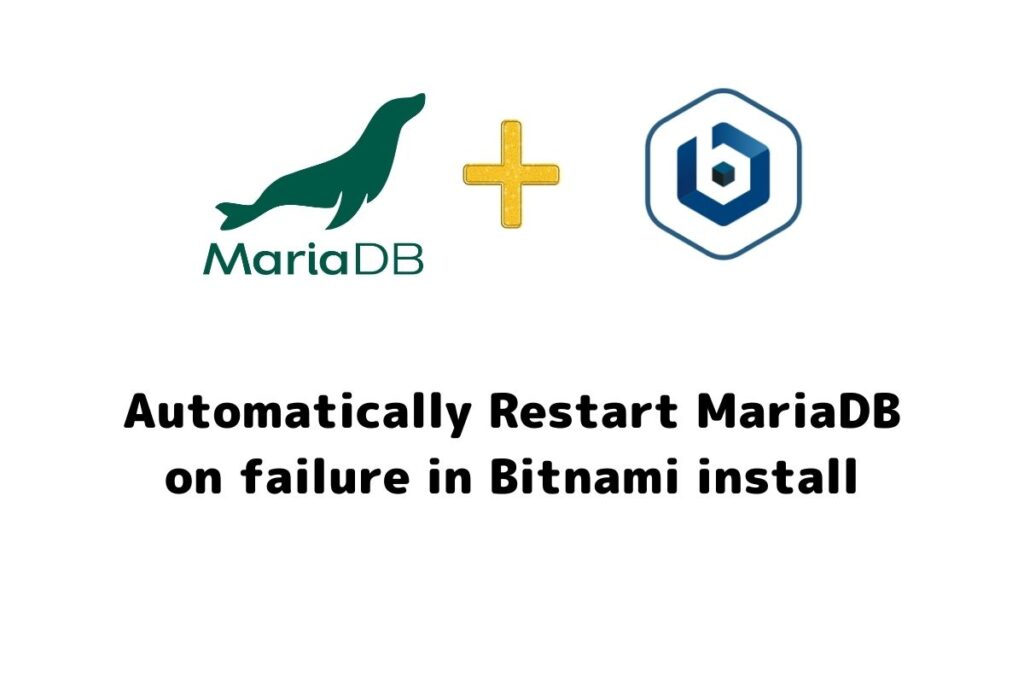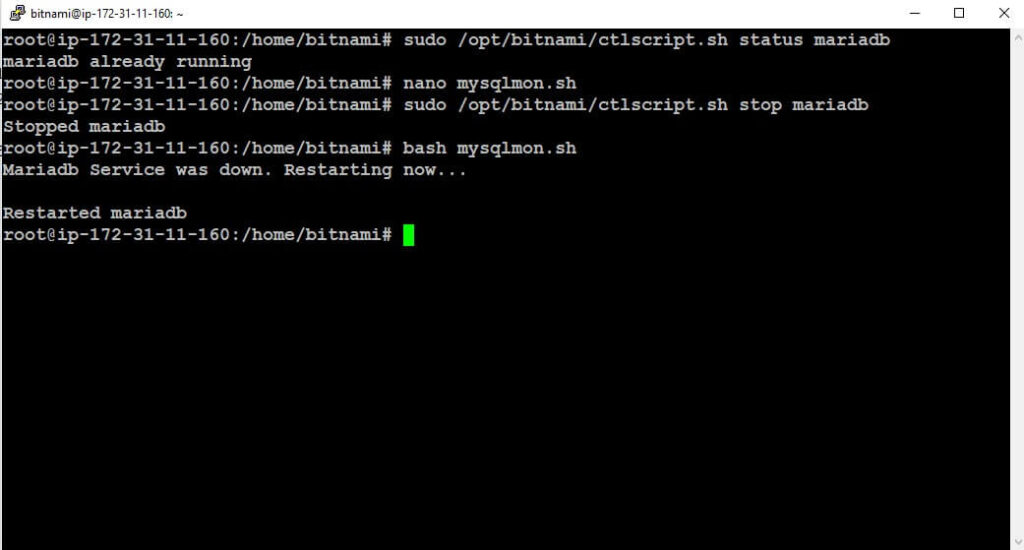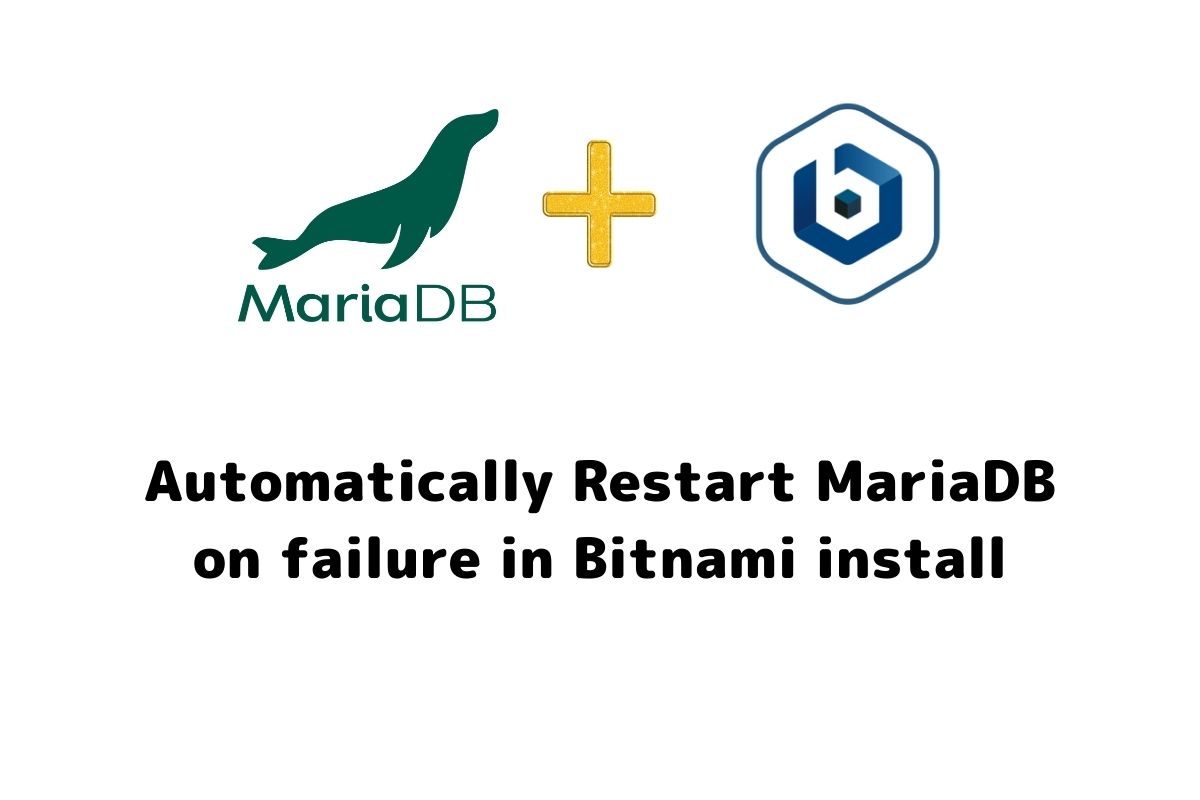In the fast-paced world of web hosting and VPS management, ensuring your services run smoothly and with minimal downtime is crucial. Suppose you’re using Bitnami for your WordPress installation on a cloud-hosted VPS such as Amazon or Google Cloud infrastructure. In that case, you’re already one step ahead regarding simplicity and efficiency. However, even the most reliable systems can face issues, and one of the most common problems is MariaDB service failure where the MariaDB service either crashes or stops running for overload or some error. In this article, we’ll explore how to automatically restart MariaDB on failure in Bitnami, so you can enjoy a seamless hosting experience.
You may also watch the video regarding this article:

The Benefits of Bitnami
Before exploring the intricacies of MariaDB failure and its resolution, let’s take a moment to highlight the advantages of using Bitnami for your WordPress hosting.
Bitnami is a well-known name in the world of cloud hosting and VPS installations, and for good reason. It offers a range of pre-configured, ready-to-use software packages, making the installation process fast and straightforward. With Bitnami, you can enjoy the following benefits:
- Simplicity: Bitnami simplifies the installation and management of software stacks, reducing the time and effort required to set up your hosting environment.
- Security: Bitnami packages include regular updates and security patches, ensuring that your WordPress installation remains secure and up-to-date.
- Compatibility: Bitnami stacks are designed to work seamlessly with various cloud platforms, making it easy to deploy your WordPress site on popular providers like AWS, Google Cloud, and Azure.
- Flexibility: Bitnami offers a range of applications beyond WordPress, allowing you to expand and customize your hosting environment as your needs evolve. It also enabled you to quickly install the Let’s Encrypt SSL for your hosted domain.
You may also like to read: How to Install PHP Intl module on OneClick OpenliteSpeed WordPress Web server?
Common Reasons for MariaDB Service Failure in Bitnami
MariaDB is a crucial component of your WordPress hosting environment, responsible for managing your site’s database. While Bitnami simplifies many aspects of hosting, MariaDB can sometimes experience issues. Common reasons for MariaDB service failure in Bitnami include:
- Resource Exhaustion: If your server runs out of resources, such as memory or CPU, MariaDB can fail.
- Configuration Errors: Incorrect configuration settings can lead to MariaDB failures, preventing your WordPress site from functioning correctly.
- Software Updates: Sometimes, updates to the underlying software stack can cause compatibility issues that result in MariaDB service disruptions.
- Heavy Traffic: A sudden surge in website traffic can overload MariaDB, leading to service failures.
To address these issues and ensure that your MariaDB service stays up and running, let’s explore how to set up a monitoring script to automatically restart MariaDB upon failure.
Automatically Restart Failed MariaDB service in Bitnami
To automatically restart MariaDB when it fails in a Bitnami WordPress installation, you can create a simple monitoring script that continuously runs every minute or every 5 minutes to check the MariaDB service status and restarts it if it’s found to be crashed, stopped, or failed. Here’s a step-by-step guide:
- SSH into Your Server: Log in to your VPS server using SSH to access the command line.
- Create a Monitoring Script: Using a text editor of your choice (such as Nano or Vim), create a monitoring script. For example, you can create a file named
mariadbmon.sh. - Edit the Script: Add the following lines to your script:
if [[ $(sudo /opt/bitnami/ctlscript.sh status mariadb) == *not* ]]; then
echo -e "Mariadb Service was down. Restarting now...\n"
sudo /opt/bitnami/ctlscript.sh restart mariadb
else
echo -e "Services are running already. Nothing to do here.\n"
fiThe above scripts will check the status of MariaDB service, it the service is not running it will echo the message “Mariadb Service was down. Restarting now…” and will restart the mariaDB service using the bitnami restart command. If the service is already running it will send the message “Services are running already. Nothing to do here.” You can eliminate the message messages generated by echo command and use the following instead to do it quietly.

if [[ $(sudo /opt/bitnami/ctlscript.sh status mariadb) == *not* ]]; then sudo /opt/bitnami/ctlscript.sh restart mariadb fi
4. Make the Script Executable: Make the script executable by running the following command:
chmod +x mariadbmon.sh
5. Set Up a Cron Job: Create a cron job to run the monitoring script at regular intervals to check and restart MariaDB. To open the crontab file for editing, use the command:
crontab -e
if you run the above command for the first time, the OS may ask you to select the preferred text editor. You can choose nano or vim by typing the number it is shown at. Select the choice and hit enter.
You can add the following line to run the script every 5 minutes:
* * * * * /bin/bash /home/bitnami/mariadbmon.sh> /dev/null 2>&1
6. Save and Exit: Save the changes and exit the text editor. Follow the instruction on the screen to save and exit the editor. If you are using nano editor, press ctrl+x to exit, and it will ask to save the file, press y to save. That’s it.
With this script and cron job in place, your MariaDB service will be automatically monitored, and in the event of a failure, it will be promptly restarted, minimizing downtime and ensuring your WordPress site stays accessible. You can use the same approach to setup monitoring and automatic restart of several other services. In case you need any help with your server or want someone to fix the problem you are having. You can contact us through skype id: live:hawkdivetech.
In conclusion, Bitnami simplifies the process of hosting WordPress on a cloud VPS, offering numerous benefits. While MariaDB service failure can occur, setting up a monitoring script to automatically restart it is a straightforward solution. By following the steps outlined in this article, you can ensure the reliability of your MariaDB service and enjoy a smoother hosting experience.




































